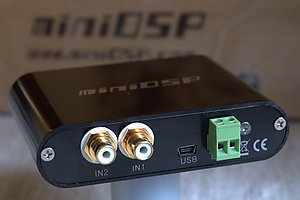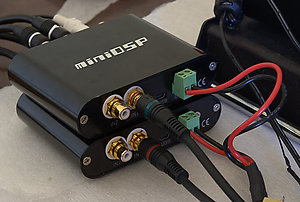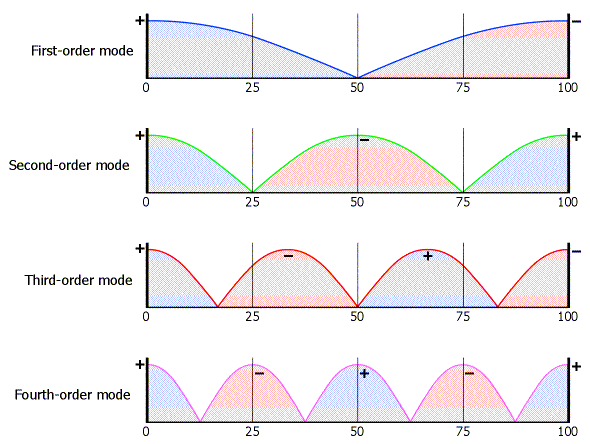Hi, Folks.
I have a 3-way project that I started a couple of years ago and then put on the back burner. I've now resurrected it, but this time using a miniDSP and active crossovers. So far, I've built a test-box to prove the concept. If it works, I'll build a pair of fancy cabinets and I'll document the whole thing at that time. Unfortunately, I have a problem with the woofers...
The problem is that the bass has some "fuzzy" distortion. It also doesn't play as low as I expected, but that's secondary at the moment. The bass sounds like the player of a string bass isn't clamping down on the strings tightly enough, or that the skins on a drum are loose. It's not "listenable" as it is.
The design uses a pair of Peerless HDS 830883 6.5" woofers connected in parallel. As you can see in the photograph, the box is lined with a combination of acoustic convoluted foam and rigid fibreglass. The midrange is sealed in a pyramid-shaped enclosure. The space outside the apex of the pyramid connects the lower four levels to the tweeter level at the top for a total of 40 to 45 litres. The second level up houses a rear-facing 3" diameter port about 7" long flared at one end.
I have run the woofers in parallel and individually, so it's not a faulty woofer - it would have to be both, which seems unlikely. I can mute the mid and tweet, which means that I can eliminate those, as well as any interaction they might be having with the woofers. I have also eliminated the amplifier. I'm crossing to the mid at 325 Hz with a LR 12dB slope (I've tried 24 dB as well). I have also tried a LR 48dB at 35 Hz in case there's anything nasty happening low down. The box is 3/4" MDF with braces dadoed in. The baffle is held on with 14 woodscrews and is sealed with draft-excluder - there's nothing loose. The woofers have six mounting holes; I'm using woodscrews in just three of them, but they are tight and there really is little or no vibration to be felt.
I'm not very knowledgeable when it comes to the electrical side of speakers, so I'm hoping that the problem is something basic that I've overlooked. In any event, I need some help!
Anyone have any ideas?
Thanks in advance,
Martyn

I have a 3-way project that I started a couple of years ago and then put on the back burner. I've now resurrected it, but this time using a miniDSP and active crossovers. So far, I've built a test-box to prove the concept. If it works, I'll build a pair of fancy cabinets and I'll document the whole thing at that time. Unfortunately, I have a problem with the woofers...
The problem is that the bass has some "fuzzy" distortion. It also doesn't play as low as I expected, but that's secondary at the moment. The bass sounds like the player of a string bass isn't clamping down on the strings tightly enough, or that the skins on a drum are loose. It's not "listenable" as it is.
The design uses a pair of Peerless HDS 830883 6.5" woofers connected in parallel. As you can see in the photograph, the box is lined with a combination of acoustic convoluted foam and rigid fibreglass. The midrange is sealed in a pyramid-shaped enclosure. The space outside the apex of the pyramid connects the lower four levels to the tweeter level at the top for a total of 40 to 45 litres. The second level up houses a rear-facing 3" diameter port about 7" long flared at one end.
I have run the woofers in parallel and individually, so it's not a faulty woofer - it would have to be both, which seems unlikely. I can mute the mid and tweet, which means that I can eliminate those, as well as any interaction they might be having with the woofers. I have also eliminated the amplifier. I'm crossing to the mid at 325 Hz with a LR 12dB slope (I've tried 24 dB as well). I have also tried a LR 48dB at 35 Hz in case there's anything nasty happening low down. The box is 3/4" MDF with braces dadoed in. The baffle is held on with 14 woodscrews and is sealed with draft-excluder - there's nothing loose. The woofers have six mounting holes; I'm using woodscrews in just three of them, but they are tight and there really is little or no vibration to be felt.
I'm not very knowledgeable when it comes to the electrical side of speakers, so I'm hoping that the problem is something basic that I've overlooked. In any event, I need some help!
Anyone have any ideas?
Thanks in advance,
Martyn





Comment